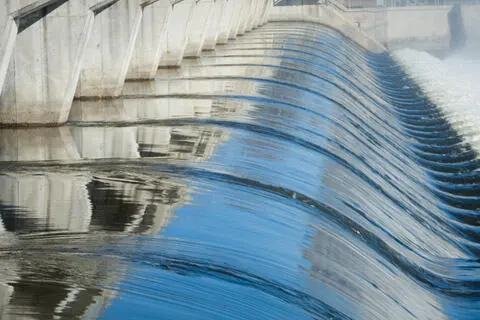Hydroelectric Energy Standards

Hydroelectric power standards address the commissioning, design, installation, control, use, and rehabilitation of hydroelectric generating plants and their components. Included as well are standards for fire protection, nomenclature, and identification. Control is a frequently addressed subject, with individual standards covering different aspects of a hydroelectric power plant. Similarly, communication networks for automation are addressed in a series of standards.
Taken together, standards for hydroelectric power generation reflect the scale of the undertaking that is commissioning, building, and operating the interwoven combination of multiple systems that all have to work smoothly for long periods of time with a large amount of civilians depending on its stability.
For more information, download the Hydroelectric Pamphlet published by Department of the Interior Bureau of Reclamation (PDF link).
IEEE 1248-2020
IEEE Guide for the Commissioning of Electrical Systems in Hydroelectric Power Plants
Inspection procedures and tests for use following the completion of the installation of components and systems through to commercial operation are provided. This guide is directed to plant owners, designers, and contractors involved in the commissioning of electrical systems of hydroelectric plants.
IEEE 1095-2012
IEEE Guide for the Installation of Vertical Generators and Generator/Motors for Hydroelectric Applications
The procedures for installation described in this guide apply to all types of synchronous generators and generator/motors rated 5 MVA and above to be coupled to hydraulic turbines or hydraulic pump/turbines having vertical shafts.
IEEE 807-2011
IEEE Recommended Practice for Unique Identification in Hydroelectric Facilities
A unique identification system for hydroelectric facilities that segregates and incorporates plant, unit, system, and component identifiers as a minimum is provided.
IEEE Std 1010-2006
IEEE Guide for Control of Hydroelectric Power Plants
This guide is to serve as a reference document for practicing engineers in the hydroelectric industry. It documents prevailing industry practices in hydroelectric power plant control system logic, control system configurations, and control modes. It describes the control and monitoring requirements for equipment and systems associated with conventional and pumped-storage hydroelectric plants. It includes typical methods of local and remote control, details of the control interfaces for plant equipment, requirements for centralized and off-site control.
IEEE 1249-2013
IEEE Guide for Computer-based Control for Hydroelectric Power Plant Automation
This guide addresses the application, design concepts, and implementation of computer-based control systems for hydroelectric plant automation. It addresses functional capabilities, performance requirements, interface requirements, hardware considerations, and operator training. It includes recommendations for system testing and acceptance. The electrical protective system (generator and step-up transformer) is beyond the scope of this guide.
IEEE 1020-2011
IEEE Guide for Control of Small (100 kVA to 5 MVA) Hydroelectric Power Plants
Description of the electrical control and monitoring requirements for equipment and systems associated with small (100 kVA to 5 MVA) hydroelectric power plants.
IEEE 1147-2021
IEEE Guide for the Rehabilitation of Hydroelectric Power Plants
Revision Standard - Active. This guide is intended for the hydroelectric power industry to assist hydroelectric power plant owners, operators, and designers in the economic (feasibility) and technical evaluation (electrical aspects) of existing hydroelectric installations for rehabilitation. It addresses conventional hydropower. Portions of this guide are relevant to pumped storage, but the unique features of pumped storage are not covered. Feasibility study results may indicate redevelopment of the site. Redevelopment will not be treated in detail in this guide. This guide covers all generating equipment up to and including the main transformer and typical auxiliary equipment.
IEEE 1207-2011
IEEE Guide for the Application of Turbine Governing Systems for Hydroelectric Generating Units
This guide is intended to complement IEEE Std 125, providing application details and addressing the impact of plant and system features on hydroelectric unit governing performance. It provides guidance for the design and application of hydroelectric turbine governing systems. There is a heightened awareness within the electric utility industry of the importance in the effective application of governing systems for dynamic stability. The need exists to provide guidance in the effective governing system application for a better understanding among users.
NFPA 850-2020
NFPA 850 Recommended Practice for Fire Protection for Electric Generating Plants and High Voltage Direct Current Converter Stations, 2020 edition
This document provides recommendations for fire prevention and fire protection for electric generating plants and high voltage direct current converter stations, except as follows: Advanced light water reactor electric generating plants are addressed in NFPA 804; nuclear power plants are addressed in NFPA 805; and fuel cells are addressed in NFPA 853.
ASTM D6439-11(2017)
Standard Guide for Cleaning, Flushing, and Purification of Steam, Gas, and Hydroelectric Turbine Lubrication Systems
1.1 This guide covers types of contaminants, oil purification devices, contamination monitoring, contamination control during building or refurbishing of turbine systems, lubrication system flushing, and maintenance of pure lubrication oil. 1.2 To obtain maximum operating life and reliability, or lubricants and system, it is vital that the turbine lubrication system has pure oil. This guide is intended to aid the equipment manufacturer, installer, and turbine operator in coordinating their efforts to obtain and maintain clean lubrication and control systems. These systems may be on land or marine turbine generators and propulsion and mechanical drive equipment. This guide is generalized due to variations in the type of equipment, builder's practices, and operating conditions. 1.3 This guide primarily addresses petroleum based lubricating oil. For systems using nonpetroleum based fluids, this guide may not be appropriate. For nonpetroleum products, consult the equipment and fluid manufacturers. 1.4 This guide is applicable to both large and small lubrication systems. Some equipment specified herein, however, may not be appropriate for all systems. Moreover, in situations where specific guidelines and procedures are provided by the equipment manufacturer, such procedures should take precedence over the recommendations of this guide. 1.5 This standard does not purport to address the safety concerns, if any, associated with its use. It is the responsibility of the user of this standard to establish appropriate safety and health practices and determine the applicability of regulatory limitations prior to use. 1.6 This international standard was developed in accordance with internationally recognized principles on standardization established in the Decision on Principles for the Development of International Standards, Guides and Recommendations issued by the World Trade Organization Technical Barriers to Trade (TBT) Committee.
IEC 61116 Ed. 1.0 b:1992
Electromechanical equipment guide for small hydroelectric installations
Provides the future purchaser with information allowing him to prepare the required documents, from the call for tenders up to acceptance tests and operation of electromechanical equipment. Applies to installations having outputs of less than 5 MW and turbines with diameters less than 3 m.

IEC 61850-7-410 Ed. 2.0 b:2012
Communication networks and systems for power utility automation - Part 7-410: Basic communication structure - Hydroelectric power plants - Communication for monitoring and control
IEC 61850-7-410:2012 specifies the additional common data classes, logical nodes and data objects required for the use of IEC 61850 in a hydropower plant. The main changes with respect to the previous edition are as follows: - the logical nodes in IEC 61850-7-410:2007 that were not specific to hydropower plants have been transferred to IEC 61850-7-4:2010; - the definitions of logical nodes in this edition of IEC 61850-7-410 have been updated; - most of the modelling examples and background information included in IEC 61850-7-410:2007 have been transferred to IEC/TR 61850-7-510. This new edition of IEC 61850-7-410 includes additional general-purpose logical nodes that were not included in IEC 61850-7-4:2010, but are required in order to represent the complete control and monitoring system of a hydropower plant.
IEC 62006 Ed. 1.0 b:2010
Hydraulic machines - Acceptance tests of small hydroelectric installations
"IEC 62006:2010 defines the test, the measuring methods and the contractual guarantee conditions for field acceptance tests of the generating machinery in small hydroelectric power installations. It applies to installations containing impulse or reaction turbines with unit power up to about 15 MW and reference diameter of about 3 m. The driven generator can be of synchronous or asynchronous type. This International Standard contains information about most of the tests required for acceptance of the hydraulic turbine such as safety approval tests, trial operating and reliability tests, as well for verification of cavitation, noise and vibration conditions, if required. This standard represents the typical methods used on smaller hydroelectric installations, and is divided into three classes as follows: Class A: Default, normal test program (panel measurement), to determine the maximum output of the installation. Class B: Recommended, extended test program, to determine the performance characteristics of the installation. Class C: Optional, comprehensive test program, to determine the absolute efficiency of the installation. All classes contain safety tests, trial operating tests, and reliability tests. This standard gives all necessary references for the contract in order to execute the test, evaluate, calculate and compare the result to the guarantee for all the classes A, B and C. "

IEC/TR 61850-7-510 Ed. 2.0 en:2021
Communication networks and systems for power utility automation - Part 7-510: Basic communication structure - Hydroelectric power plants, steam and gas turbines - Modelling concepts and guidelines
IEC TR 61850-7-510:2021(E), which is a technical report, is intended to provide explanations on how to use the Logical Nodes defined in IEC 61850-7-410 as well as other documents in the IEC 61850 series to model complex control functions in power plants, including variable speed pumped storage power plants. IEC 61850-7-410 introduced the general modelling concepts of IEC 61850 for power plants. It is however not obvious from the standard how the modelling concepts can be implemented in actual power plants. This document explains how the data model and the concepts defined in the IEC 61850 standard can be applied in Hydro; both directly at the process control level, but also for data structuring and data exchange at a higher level. Application of the data model for Thermal is limited to power evacuation (in principle the extraction of the generated electrical power) and the prime mover shaft and bearing system. The interfaces of the fuel and steam valves are modelled for the purpose of process control. Communication services, and description of the use of mappings of the IEC 61850 data model to different communication protocols, are outside the scope of this document. This second edition cancels and replaces the first edition published in 2012. This edition constitutes a technical revision. This edition includes the following significant technical changes with respect to the previous edition: a) Process modelling according to IEC 61850-6:2009, including IEC 61850-6:2009/AMD1:2018. b) Examples of application of Reference Designation System together with the process modelling, in particular application of IEC/ISO 81346. c) Description of modelling related to Steam- and Gas turbines. d) Annexes with examples of application of SCL according to the examples in the Technical Report. e) The dynamic exchange of values by using polling, GOOSE, Reporting or Sampled Values is no longer included in the Technical Report.
IEC 62270 Ed. 2.0 b:2013
Guide for computer based control for hydroelectric power plant automation
IEC 62270:2013 addresses the application, design concepts, and implementation of computer-based control systems for hydroelectric plant automation. It addresses functional capabilities, performance requirements, interface requirements, hardware considerations, and operator training. It includes recommendations for system testing and acceptance. The electrical protective system (generator and step-up transformer) is beyond the scope of this guide. This second edition cancels and replaces the first edition published in 2004. This edition constitutes a technical revision. This edition includes the following significant technical changes with respect to the previous edition: - update of system architecture aspects, with different process control system configurations; - update of communications, user and plant interfaces aspects; - suppression of case studies, because of the quickness of evolution of the technology; - complete review of the bibliography, making mention of many IEC and IEEE standards as new references and addition of a new informative Annex B on legacy control systems. This publication is published as an IEC/IEEE Dual Logo standard. Key words: Hydroelectric, Automation, Computer-Based Control
